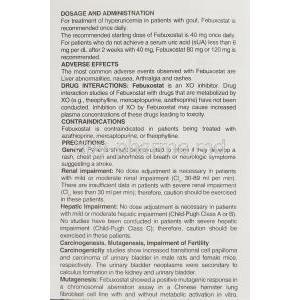I. Introduction
A Brief Overview of Febuxostat Febuxostat is a medication primarily prescribed to treat chronic gout and hyperuricemia. It works by inhibiting certain substances in the body, relieving the painful symptoms associated with gout, and helping regulate uric acid levels in individuals undergoing chemotherapy. The Importance of Treating Gout and Hyperuricemia This drug plays a role in managing the debilitating effects of gout, a type of arthritis, and maintaining proper levels of uric acid in patients receiving chemotherapy. Scope of this Article The purpose of this article is to provide an understanding of Febuxostat. It will cover its mechanism of action, approved uses, off-label applications, recommended dosage guidelines, and potential side effects.
II. What is Febuxostat?
Febuxostat is composed of a thiazole derivative, which plays a role in its effectiveness as a medication. Initially approved by the FDA in 2009, Febuxostat was developed as a treatment for individuals who cannot tolerate conventional gout medications like allopurinol. Febuxostat has gained recognition and approval from agencies worldwide, including the FDA, EMA, and various regulatory bodies in Asia.
III. How Febuxostat Works
Febuxostat works by blocking the action of an enzyme called xanthine oxidase, which produces uric acid. This helps reduce the chances of flare-ups and the formation of tophi. Regarding medications used for gout, Febuxostat has an advantage over allopurinol because it doesn't require dose adjustments in people with kidney problems. This makes it a unique and beneficial option for treatment.
IV. Approved Uses of Febuxostat
Febuxostat is a medication that belongs to a class of drugs called xanthine oxidase inhibitors. It works by lowering uric acid levels in the blood, a substance that can cause gout, a type of arthritis that causes pain and inflammation in the joints. Febuxostat is mainly used to treat chronic gout in patients with high uric acid levels and cannot tolerate or respond to other gout medications1.
Febuxostat may also be used to prevent tumor lysis syndrome. This severe condition can occur in patients with certain types of cancer, such as leukemia or lymphoma, undergoing chemotherapy. Chemotherapy can cause rapid breakdown of cancer cells, which releases large amounts of uric acid and other substances into the blood. This can overwhelm the kidneys and cause kidney failure, electrolyte imbalance, seizures, and even death. Febuxostat can help reduce the risk of tumor lysis syndrome by lowering uric acid levels and preventing kidney damage.
However, febuxostat is not approved by the FDA for this indication and should only be used under the supervision of a doctor. Febuxostat may also have side effects, such as liver problems, skin rash, nausea, joint pain, and increased risk of cardiovascular events. Therefore, febuxostat should be used with caution and regular monitoring of blood tests and symptoms.
References:
V. Off-Label Uses of Febuxostat
- Managing asymptomatic hyperuricemia: This is a condition where the blood level of uric acid is high, but there are no symptoms or signs of gout, kidney stones, or kidney damage. Some doctors may support lowering the uric acid level in this situation, especially if there are other risk factors for cardiovascular or renal disease, but there is no clear evidence that this improves outcomes or prevents complications1.
- Potential for treating cardiovascular conditions: Uric acid may have a role in causing or worsening cardiovascular diseases, such as hypertension, atherosclerosis, heart failure, and stroke, by triggering inflammation, oxidative stress, insulin resistance, and endothelial dysfunction. Some studies are evaluating whether lowering uric acid levels can reduce the risk or severity of these conditions, but the results are not conclusive yet2.
- Exploring experimental applications in neurodegenerative diseases: Uric acid may have a protective effect on the brain by acting as an antioxidant and modulating neurotransmission and neuroinflammation. Some research has shown promising results in slowing down the progression of conditions such as Parkinson’s and Alzheimer’s disease by increasing uric acid levels or using uric acid analogs, but more clinical trials are needed to confirm this3.
References:
VI. Dosage and Administration
Typical Dosage Recommendations The suggested starting dose is 40 mg taken daily, and if necessary it can be increased to 80 mg to manage high levels of uricemia. Adjusting the Dose for Kidney or Liver Impairment There is no need to change the dosage, for kidney impairment. It's important to use caution when dealing with liver insufficiency. Ways of Administering Febuxostat is typically taken orally in the form of tablets.
VII. Important Precautions for Administration
Before starting the treatment, conducting an assessment that includes tests to evaluate kidney and liver function is advisable. To ensure the dosage is adjusted appropriately, monitoring the uric acid levels during the treatment is recommended. If a dose is missed, it is recommended to take it unless its almost time for the next scheduled dose.
VIII. Special Populations
Please use caution when giving this medication to patients as they may be more vulnerable to its potential side effects. It is important to note that the impact of using Febuxostat during pregnancy is not fully understood, as it falls under Category C for pregnancy drugs. Therefore, its impact on development is unknown. Additionally, the safety and effectiveness of Febuxostat in children have not been thoroughly studied.
IX. Common Side Effects of Febuxostat
Gastrointestinal symptoms, such as nausea, indigestion, and slight elevation in liver enzymes, may occur. There is a possibility of an increased risk of cardiovascular events. It is crucial to monitor renal parameters closely while undergoing treatment.
X. Warnings and Contraindications
Health Conditions Not Recommended: Febuxostat should not be used by individuals with a known allergy or hypersensitivity to the medication. Important Safety Notice: The FDA has issued a safety warning called a black box warning regarding an increased risk of death compared to the alternative medication allopurinol. When to Seek Urgent Medical Assistance: If you experience any skin rash, irregular heartbeat, or persistent gastrointestinal symptoms, it is crucial to seek immediate medical attention.
XI. Drug Interactions
When using Febuxostat along with medications for gout like colchicine or probenecid, it is essential to closely monitor the effects as they can have additive pharmacological effects. If you are taking drugs or antiarrhythmics along with Febuxostat, your doctor may need to adjust the dosage and monitor you more closely for potential adverse effects. It is recommended to exercise caution when combining Febuxostat with supplements such as turmeric or fish oil, as these supplements can affect uric acid levels and potentially reduce the effectiveness of the medication.

XII. Careful Administration and Handling Precautions
To store Febuxostat tablets correctly, keep them in a container at room temperature, away from moisture, heat, and direct sunlight. It's essential to follow these guidelines to maintain the effectiveness of the medication and prevent any degradation. When disposing of unused medicines, authorized medical waste management services must be used. Improper disposal can have environmental consequences. In hospital and clinical settings, healthcare professionals must follow precautions such as wearing gloves and practicing proper hand hygiene when administering and handling Febuxostat. These safety measures ensure the well-being of both patients and practitioners.
XIII. Overdosage and Emergency Measures
Signs of taking much Febuxostat can include feelings of nausea, dizziness, and increased levels of liver enzymes. In some cases, individuals may experience irregular heart rhythms or changes in mental state. If an overdose occurs, it is essential to seek medical attention. Treatment typically involves lavage or the administration of activated charcoal to help remove the excess medication from the body. After an overdose, it is crucial to monitor vital signs, kidney function, and liver indicators for potential complications.
XIV. Conclusion
Critical Takeaways Summary: Febuxostat has established itself as a chronic gout and hyperuricemia treatment. It has shown efficacy and a relatively safe side effect profile. The Importance of Medical Guidance: Although generally safe, it is crucial to have medical supervision when using this medication to minimize any possible negative interactions or side effects. Future Research Directions: Ongoing and upcoming studies are focused on exploring the potential of this drug in treating conditions such as cardiovascular diseases and neurodegenerative disorders, thus broadening its therapeutic applications.





















































